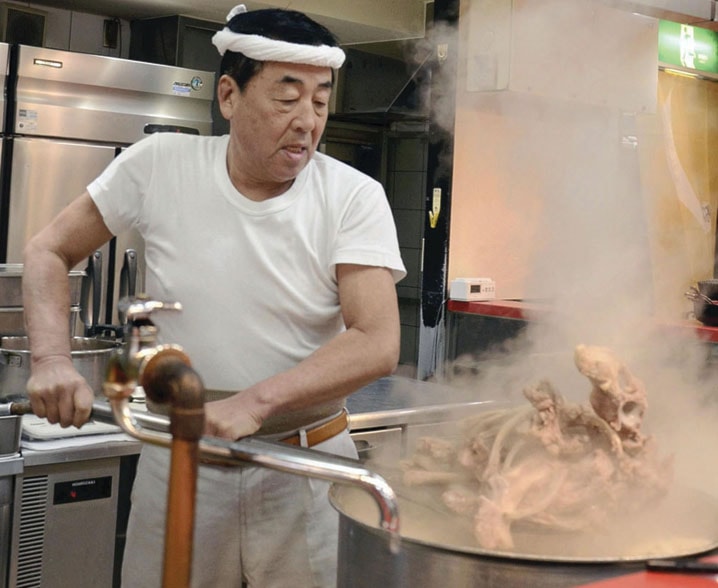YOKOHAMA, Japan — Forty years after it was first served, iekei ramen is poised to take on the world. The distinctive broth consisting of a blend of tonkotsu pork bone soup and soy sauce nestling thick, straight noodles was created at the Yoshimuraya ramen shop, which opened in Yokohama, in 1974.
Its popularity sparked the emergence of similar ramen shops across Japan, including those run by longtime employees of Yoshimuraya who were allowed to set up a branch of their own. They all add “ya” (which means house) to the end of the shops’ names in a nod to Yoshimuraya. The iekei hybrid has since become a genre of ramen that sits comfortably alongside other giants of local specialty ramen, such as Hakata’s tonkotsu and Sapporo’s miso ramen. Iekei means house-style.
And now, iekei ramen is set to change the way many non-Japanese view the dish. Hong Kong’s Causeway Bay district is packed with luxury boutiques, stores and expensive foreign automobile dealerships. On Dec. 13 last year, a new iekei ramen shop opened in a corner of this bustling, economically vibrant district. Stories about the first overseas outlet of the Matsuichiya ramen chain were splashed across Hong Kong’s newspapers and magazines when it opened.
“A new genre of ramen from Yokohama, Japan, has touched down in Hong Kong for the first time,” one report said.
On its first day, about 600 bowls of ramen were served in just eight hours. In less time than it takes to slurp a noodle, Matsuichiya became a popular attraction.
Matsuichiya’s first shop opened in Fujisawa. It was founded by Katsunari Matsuno, president of MG Holdings Co., which operates about 60 eating establishments.
“Many people know about tonkotsu ramen, but I believe iekei ramen is just as delicious. I felt there was an opening to be successful overseas with this ramen,” said Matsuno, 40.
Matsuichiya’s five shops in Japan include ones in Fujisawa and Chigasaki. Excited by the growing ramen boom abroad, Matsuno decided to open a shop in Hong Kong, where he has several acquaintances.
Many tonkotsu ramen shops have popped up overseas in recent years, led by the Fukuoka-based Ippudo and Ichiran chains.
Although these stores have contributed significantly to the development of Japanese ramen brands, people in many areas now tend to assume tonkotsu is the only ramen flavor. Tonkotsu ramen is characterized by a creamy soup and thin noodles, whereas iekei ramen features a broth made from pork bones, chicken stock and soy sauce, uses fatter, chewy noodles, and is usually topped with boiled spinach, nori and chashu roasted pork. There are estimated to be about 1,000 iekei ramen establishments, mainly in Japan and other parts of Asia.
The flavors and noodles can vary between iekei shops, but Matsuno felt that delivering a quality product would be the best recipe for success.
“If we make it carefully, it will definitely sell,” he recalled thinking. He dispatched rising ramen chef Daigo Sato to head the Hong Kong shop.
Noodles, pork bones and other important ingredients are shipped directly from Yokohama to Hong Kong, where the chefs prepare ramen that tastes identical to the dishes served in Japan. Although Hong Kong locals quickly gave the flavor a thumbs-up, Matsuichiya had to tweak some elements of its meals to accommodate local preferences. Customers there were more accustomed to skinnier noodles, so Matsuichiya adjusted the width of its noodles. Others complained when the air conditioning was not set to a temperature cold enough to make people put their jacket on, while others wanted carbonated beverages with their meals because they would not drink chilled water.
“There are new surprises every day,” said Sato, 31. “I want to listen to what our customers say and keep refining our ramen.”
Matsuno threw himself into the ramen industry about 20 years ago and now he has lofty ambitions for the humble dish.
“Iekei ramen means everything to me. I want to make it more popular overseas, so that people will say, ‘This is Japanese ramen,’ “ he said.
Iekei ramen has already tickled the taste buds of — and won over — some foreigners. Umami Mart is a website introducing Japanese cuisine and culture. It features blogs by writers who offer their thoughts and insights on every aspect of Japanese food. Among them is Will VanderWyden, a 34-year-old American who has been writing only about ramen for several years.
In May 2012, VanderWyden visited Japan for the second time and encountered iekei ramen for the first time. His initial reaction was mostly positive.
“I enjoyed this bowl immensely . . . this bowl was delicious. I’m probably just not the complete iekei guy,” he wrote in a post about his visit to the Nakamuraya ramen shop in Bunkyo Ward, Tokyo.
He ate 21 bowls of ramen during that trip and then polished off another 21 during a visit in May 2013. Infatuated with the taste and texture of ramen, VanderWyden moved to Japan in January this year. He eats ramen three or four times a week, and then writes about his thoughts on each meal.
After he graduated from college, VanderWyden had moved to Los Angeles, which is home to 30 to 40 ramen shops. Most serve tonkotsu ramen.
“Tonkotsu is very popular, but it doesn’t have the same impact that I got when I ate iekei ramen,” he said.
VanderWyden said he continues to update his blog because he wants more foreigners to know that Japan has many delicious ramen shops.
He has recently received requests for restaurant recommendations from people planning to visit Japan. In February, VanderWyden began working part-time at a ramen shop.
His dream is to open a ramen restaurant serving a tonkotsu and soy sauce soup in Los Angeles. VanderWyden is confident that iekei ramen will find popularity in other countries. “It’s the soul of Japan,” he said.
